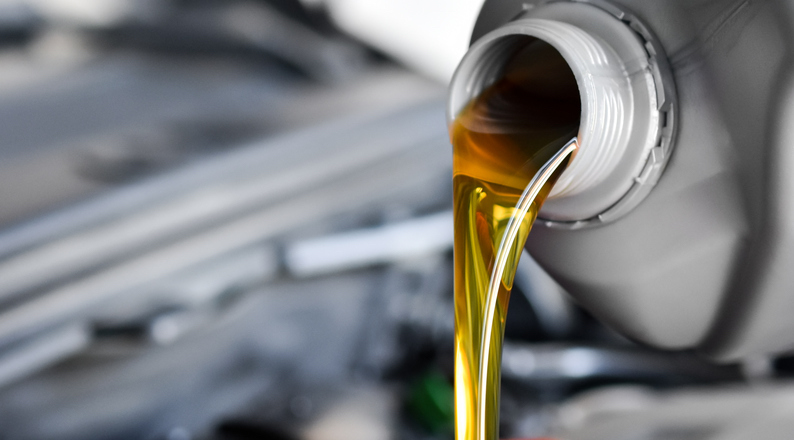Changing the oil is one of the easiest maintenance jobs for your car. By regularly doing it yourself, you will not only keep your car in tip-top condition, you will save yourself money when getting it serviced. There are a number of different types of car oil, and although decoding the information on the bottle can seem daunting, once you understand them, it’s not as complicated as it may first seem.

Types of oil
Oil can be synthetic, conventional, or a blend of the two. There are differences between the types, which will affect how it performs in your car.
Conventional motor oil
Conventional motor oil is refined crude oil i.e. oil that is pumped through the ground that has gone through a refining process.
Fully synthetic oil
Fully synthetic oils not only go through the refining process, they are broken down to a molecular level, where impurities are removed, and specialised compounds created. As these compounds are produced specifically to be used in modern engines, they give higher levels of performance and protection than conventional oils can.
Even within the fully synthetic range, there are huge differences between different formulations. Depending on your needs, you might choose a synthetic oil that is designed to keep your engine cleaner, protect your engine, work better at low temperatures, or offer better fuel economy. Some synthetic oil combinations will offer more than one of these features.
Synthetic blend oil
As the name suggests, a synthetic blend oil combines both conventional and synthetic motor oils. It won’t have the same level of additives as a fully synthetic oil, but will still have some of the performance and protection properties.
What do the numbers on the bottle mean?
Grade
The grade will be shown as two numbers, separated by the letter ‘w’, such as 5w40. The numbers give an indication of the oil’s resistance to flow, or to put it simply, how thin it is. The number before the ‘w’ is the resistance at winter temperatures. The lower the number, the better its performance at cold temperatures, or from cold starts. The number after the ‘w’ is the resistance at 100°C, with a lower number meaning the oil is thinner. You should use the grade specified in your vehicle’s handbook, as not all grades will be suitable for all vehicles.
API
API is an acronym for the American Petroleum Institute. Although an American organisation, an API number will still appear on most bottles of oil sold in the UK, and can tell you a bit about it. There are two categories for cars, starting with S for petrol cars and C for diesels. The other numbers and letters refer to the specification it meets. Unless you are driving a vintage car, you will want the latest version, which is SM for petrol engine cars, or CI4 cars with a diesel engine.
ACEA
Similarly, the European Automobile Manufacturers’ Association (known by its French acronym ACEA) have a set of oil classifications. They are split into a number of performance and application categories, which can at first appear a little confusing. The letters and numbers on the label can be broken down as follows:
| A – Petrol
B – Diesel |
1 – Fuel economy
2 – Standard performance (no longer used) 3 – High performance / extended drain 4 – Direct injection 5 – Combines economy and performance |
For example, an oil rated A1 is designed to offer fuel economy in a petrol engine car, while a B3 oil would be for a high performance diesel engine.
There are also oil grades beginning with the letter C. These can be used in both petrol and light duty diesel engines, and are based on the A5/B5 range. C1 is based on low SAPS (Sulphated Ash, Phosphorous and Sulphur), C2 is based on mid SAPS, and C3 is based on mid SAPS but with higher performance levels.
Choosing oil for your car
Your vehicle handbook will give you a recommended ACEA category, grade, and in many cases, manufacturer, for your oil. When shopping for oil, look for one that meets the recommended specification.
For best performance, buy the exact brand recommended by your vehicle handbook. Using a cheaper, unbranded oil of the same specification shouldn’t harm your vehicle if you both top it up and change it regularly, however, the big manufacturers put a lot of money into creating high performance oils, which can have benefits such as prolonging engine life, reducing fuel consumption, and not needing to be topped up as often.
Changing your oil
As well as recommending which oil you should put in your car, your vehicle handbook will tell you how often you should change your oil. Over time, contaminants will make their way to your oil. At the same time, oil will gradually boil out of your engine. If you only ever top your oil levels up, rather than replace it fully, the ratio of contaminants to oil increases, with any abrasive particles in it gradually wearing away at your engine. It is therefore important to completely change your oil on a regular basis.
Disposing of the oil responsibly
It is illegal to pour used motor oil down the drain, as it will contaminate the water system. Many household waste recycling sites will recycle motor oil for you, and in some cases, will provide you with a suitable container for transporting it in. Your council should publish information about where oil can be recycled, along with some advice on suitable containers.
Containers should be metal, or made from a suitable plastic, such as polyethylene. Oil should be kept separate from other chemicals, so you should not drain it into a container that contains, or has ever contained things like petrol, thinners, paints, solvents or cooking oils, even if you think you have cleaned the container thoroughly.
Now you’re more familiar with which oil is right for your car, make sure your car is ready for winter driving. As a new driver, it can all feel a bit confusing so be sure to learn all about your car and your insurance policy too.



